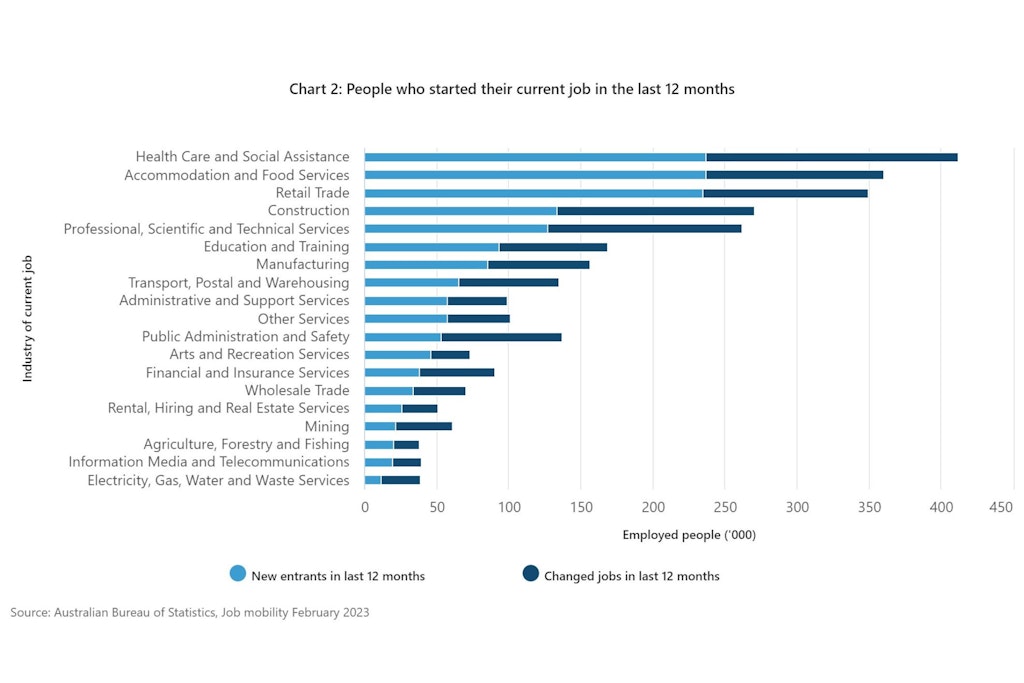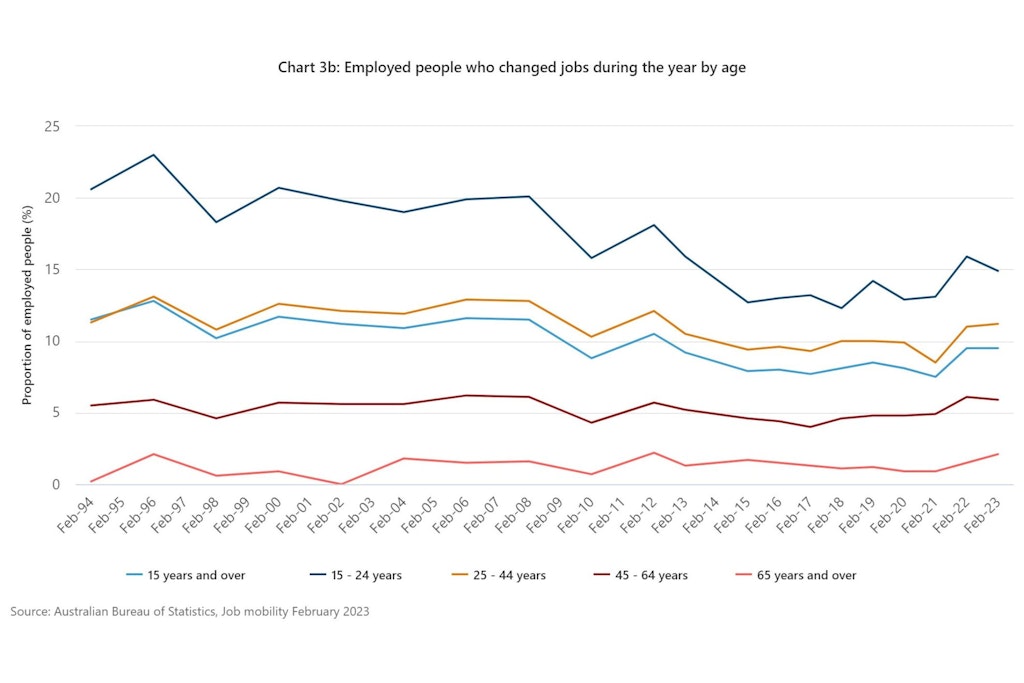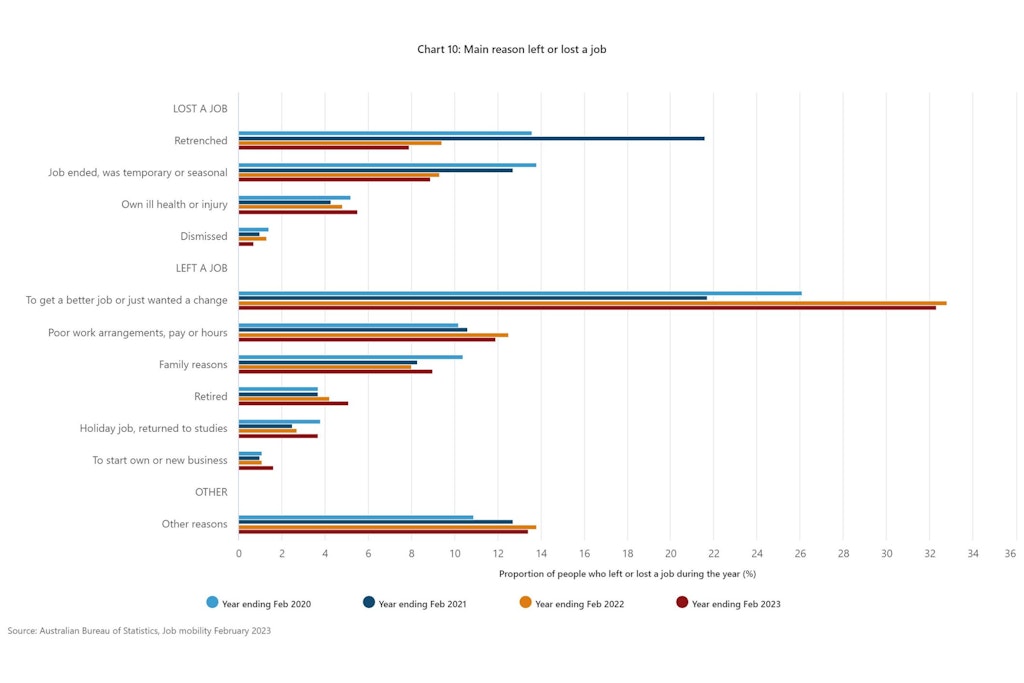ABS data reveals why 28% of the workforce has changed jobs
Published on 27 September 2023

Australia’s workforce is a fluid one: of the nearly 14 million people employed, roughly 28% of people started a new job within the past 12 months. Some of those numbers do belong to new entrants in the workforce – a welcome relief for sectors like aged care that are under the pump – although most are existing workers and industry professionals.
But why are workers moving around so much? The most recent data from the Australian Bureau of Statistics sheds plenty of light on job mobility in Australia.
A workforce on the move
- Australia’s workforce is the most mobile it’s been in a decade with 9.5% of workers changing jobs within the 12 months prior to February 2023. In terms of numbers, 2.3 million people left or lost their jobs.
- 35% of workers have been in their current job for 1-4 years, which seems to be when change occurs as only 18% of workers have held the same job for 5-9 years.
- ‘Healthcare and social assistance’ had the greatest number of new entrants to the workforce with 237,000 people, alongside 175,000 workers who changed jobs within the care industry.

Are workers more mobile than ever before?
Despite results from the last two years sitting steady at 9.5% workforce mobility, it’s actually still one of the lowest results recorded by the ABS.
Job mobility has consistently been above 10% since it was first recorded in 1972, peaking at 19.5% in 1989. It only dipped into single figures in 2010 (8.8%) with the pandemic causing all-time low mobility in 2021 (7.5%). This is a sign that the job market is healthy, and workers are regaining confidence as they explore new opportunities.
Is this a youthful trend?
Although workers aged 15-24 are among the most mobile (14.9%), so too are those aged between 25-44 (11.2%). That percentage has always been fairly consistent for ‘prime-aged workers’ in their 20s, 30s and 40s while younger workers are actually far less likely to change jobs than they did in the 1990s and 2000s.

What sectors are at risk of losing workers?
In terms of occupation, ABS data revealed that “community and personal service workers” rank fourth for job mobility with 10.7% of workers leaving their occupation.
- 10.7% is a .8% decrease from 2022, indicating a slight shift in worker movement out of the sector
- Other relevant occupations that form a key part of the sector continue to experience reasonable movement, including clerical and administrative workers (8.9%) and managers (7.6%)
It’s not all bad news, however, as there was a .2% gain for job mobility by occupation that was entered, meaning more community and personal services workers entered the occupation than left it.
As for the “health care and social assistance” industry itself, a similar trend emerged as 7.4% of the workforce left the industry (down by 1.3% from 2022) but 8.3% of workers who changed industries chose to enter the care sector.
Why are workers more likely to leave a job?
With workforce mobility on the rise, why are workers changing jobs and occupations so much?
For one-third of people, it’s simply about a desire for change or a better job. That’s a pattern that has been growing since the start of the pandemic in 2020, increasing from 26.1% to 32.3%. No other reason for movement comes close, indicating that sometimes you might just have to accept a worker wants to leave.

Other reasons listed for job movement include family reasons, retirement, the end of a short-term contract, injury/sickness, retrenchment and job dissatisfaction (poor work arrangements, pay or hours).
Interestingly, both job dissatisfaction and retirement have become more common causes for job movement over the past four years. Retirement as a reason for leaving a job has increased from 3.7% in 2020 to 5.1% in 2023, while poor work arrangements, pay or hours has grown from 10.2% to 11.9%.
What does this mean for you? Retirement becoming more common with an ageing population is something employers cannot change, but job dissatisfaction is. It’s up to you to continue working hard to attract and retain workers who are dissatisfied, particularly when they want to stay in the industry.